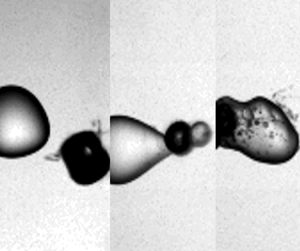Article contents
Microemulsification from single laser-induced cavitation bubbles
Published online by Cambridge University Press: 14 December 2022
Abstract

We study the interaction between a laser-induced cavitation bubble and a submillimetre-sized water droplet submerged in silicone oil. High-speed imaging reveals the pathways through which droplet fragmentation occurs and three distinct regimes of bubble–droplet interaction are identified: deformation, external emulsification and internal emulsification. We have observed that during the bubble collapse, the droplet elongates towards the bubble, which acts as a flow sink pulling on the droplet. For silicone oils with higher viscosity, the droplet jets into the cavitation bubble and forms a satellite water droplet in the continuous oil phase. In contrast, for lower-viscosity oils, the droplet encapsulates the collapsing bubble as it jets inside and undergoes multiple cycles of expansion and collapse. These internal bubble collapses create tiny oil droplets inside the parent water droplet. The kinematic viscosity of the silicone oil, maximum bubble diameter and centre-to-centre distance between the bubble and the droplet are varied. The regimes are separated in a parameter space set up by the non-dimensional distance and a cavitation Reynolds number.
- Type
- JFM Papers
- Information
- Copyright
- © The Author(s), 2022. Published by Cambridge University Press
References
REFERENCES
- 11
- Cited by



